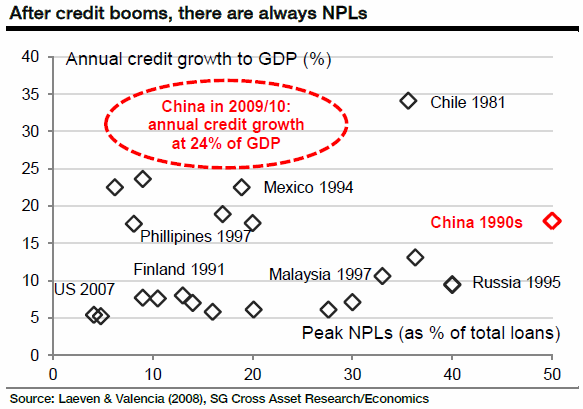“A 1 percent increase in the nonperforming-loan ratio would generate over 1 trillion yuan of non-performing assets and devour China’s banking industry profits.”
That is the lead of this week’s top story in respected Chinese finance magazine Caijing.
While in Australia our focus is most certainly on the fear that China’s fixed-asset investment slowdown could torpedo the mining boom – if it hasn’t done so already – in Beijing, non-performing loans and the spectre of shadow banking, accounting fraud and ‘triangle debt‘ is by far the bigger worry.
Looking at the official statistics, China does not have a bad debt problem, but putting blind adherence to statistics to one side a disturbing pattern emerges.
As regular readers of Macro Business and Macro Investor will know, China’s non-performing loan (NPL) ratio stands at a little under 1%, yet the spike of rolled-over debt suggests that the problem is in fact much bigger – as it was in Japan during that country’s lost decade of ‘zombie corporations’.
Further – and as supported by the sharp decline in Chinese banking shares over recent weeks – research by Société Générale strategist Wei Yao suggests that ‘special mention’ loans (i.e. doubted, but performing) could be at 3%, suggesting additional risks of a hidden NPL iceberg. Indeed, as Société Générale went on to say, it is likely that NPLs in Chian could be structural, not cyclical, as they were in the 1990s when bad debt comprised over 50% of total loans.

Now NPLs at 50% of total is surely a never-to-be-repeated outlier risk, but returning to the first point of this post and Australia’s increasingly uncertain mining boom, we only need NPLs to increase another percentage point before China faces a potential credit crunch. And with cities like Wenzhou – the epicentre of China’s shadow banking crisis, where NPLs comprised 2.69% of formal loans at end June – showing the possible future consequences of unchecked fixed capital formation and mal-investment, the omens don’t look good.
As Northwestern University academic Victor Shih has said before, the 1 trillion yuan point is where China’s central bank would need to intervene to avoid a credit crunch. And if that came as a result of NPLs (Shih has always felt capital flight – another of China’s problems – could be an equal or greater issue), then that leaves little room for additional stimulus of the kind that would stem the current fall in commodity prices.
Suddenly the issue of rescuing a deflating property bubble, or restarting a fixed-asset overhang, doesn’t seem so important. Whether or not the miners will like it, China has bigger fish to fry.